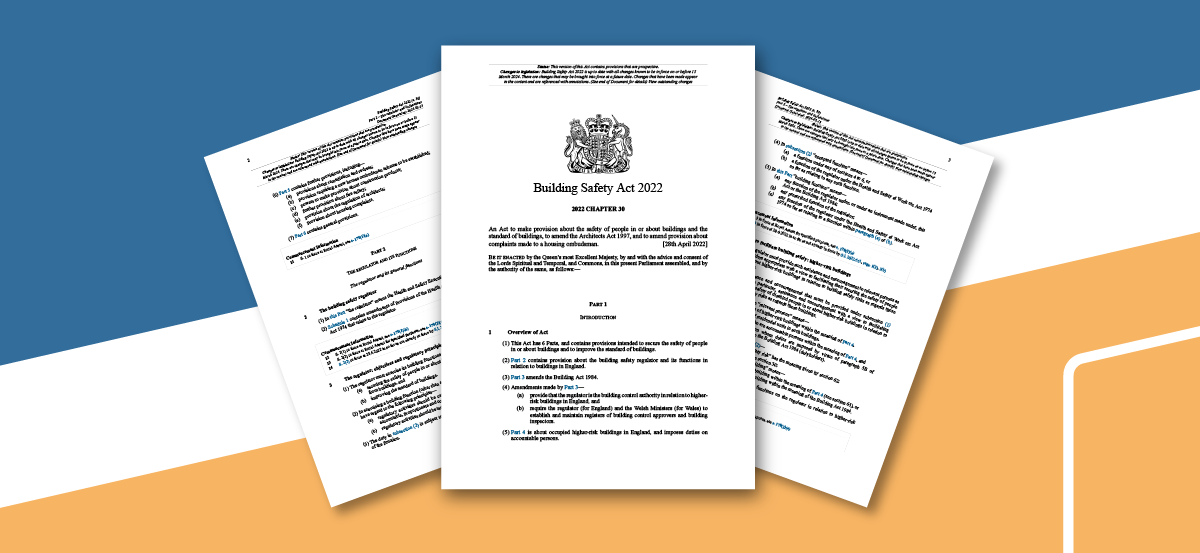Taking full effect from April 2024, the Building Safety Act is a significant landmark in the journey to creating a safer built environment, with greater accountability for fire and structural safety, following the tragic fire at Grenfell Tower and decades of variable safety practices, compounded by the lack of a clear-cut and well-enforced regulatory system. Although we are waiting for much of the secondary legislation that will explain how its core policies will be enacted, its contents provide a clear idea of the direction of travel.
The main focus of the Act is on high-risk buildings (HRBs), i.e. high-rise residential properties (including those where people reside temporarily for a period of time such as student accommodation, hospitals and care homes). However, there are further reforms which will impact the lifecycle of all building types, and everyone in the construction industry must prepare for changes to the building safety and standards regime as a whole.
Introduction of new bodies affecting all buildings
Building Safety Regulator
The Building Safety Act introduces a number of new regulatory bodies. The most notable is the new Building Safety Regulator (BSR) within the Health and Safety Executive (HSE) in Part 1 Section 3. This body is responsible for overseeing the safety and standards of all buildings and encouraging the built environment sector and building control professionals to improve their competency, including establishing and maintaining an ‘Industry Competence Committee’. It also leads the implementation of the new regulations for higher-risk, high-rise buildings, initiated by building a register of high-rise residential buildings.
This video from the HSE provides a clear overview of the function of the BSR.
National Regulator for Construction Products
Another key body introduced by Schedule 11 of the Act is the National Regulator for Construction Products (NRCP). Exactly how this body will be set up and enforced is due to be defined in upcoming secondary legislation. However, falling under the responsibility of the Office for Product Safety and Standards (OPSS), this body is designed to bolster the construction products regulatory regime and ensure that any construction product available in the UK market is safe for its intended use, regardless of building type.
It will achieve this by working with regulators to ensure clarity on how to comply with the law, supporting investigations into construction products and conducting surveillance of those on the market, enforcing the new Construction Products Regulations (regulations still awaited) and acting where risks are identified. The OPSS has already been granted the power to remove products from the market if they are deemed defective or marketed under misleading statements and therefore potentially dangerous, and to issue civil penalties and prosecutions against manufacturers who do not comply with the product safety standards.
Introduction of new systems impacting those who work on all buildings
Regulation of Building Control
The Act also includes a number of measures for people who work on all kinds of buildings.
For example, it proposes to make Building Control a regulated profession. The Act states that the BSR will introduce a new framework to outline the roles and responsibilities of building control. This includes establishing and maintaining a register of building inspectors. The register may set-out different classes of inspectors depending on experience or qualifications and will require those registered to adhere to a code of conduct, competency frameworks and more. Secondary legislation is expected to outline these requirements in more detail.
Competency frameworks
Competence is vital for all building work. Section 35 of Part 3 of the Act amends Schedule 1 of the Building Act 1984 to include mention of “Competence requirements” stating that:
- “Building regulations may, in relation to any work, impose competence requirements on—
- any appointed person, or
- any prescribed person.
- A “competence requirement” is a requirement relating to—
- the skills, knowledge, experience and behaviours of an individual;
- the capability of a person other than an individual to perform its functions under building regulations.”
It is also worth noting that, in Section 126, the Act also proposes a building industry scheme which is likely to apply to all buildings. This could limit the development of certain building types to companies and individuals that have been accepted into the scheme or schemes. However, there has not yet been any further detail of what this will look like.
Claims under Section 38 of Building Act 1984
BSA 2022 aims to bring this section into force and will apply to all building types within scope of building regulations. When in force, it allows a cause of action for physical damage (injury or damage to property) due to a breach of the building regulations.
Get ready to act
The secondary legislation relating to all aspects of the Building Safety Act is expected to take several years to be released and come into force. However, there are steps all stakeholders in the industry— from product manufacturers to contractors and developers— can take now to ensure they are acting responsibly, are working towards growing competency and putting occupier safety and wellbeing at the heart of every project.
References:
- Sawtell. (2022) The Building Safety Act 2022 and non-residential buildings. Available at: https://blogs.law.ox.ac.uk/blog-post/2022/06/building-safety-act-2022-and-non-residential-buildings – Accessed on: 20/04/2023

